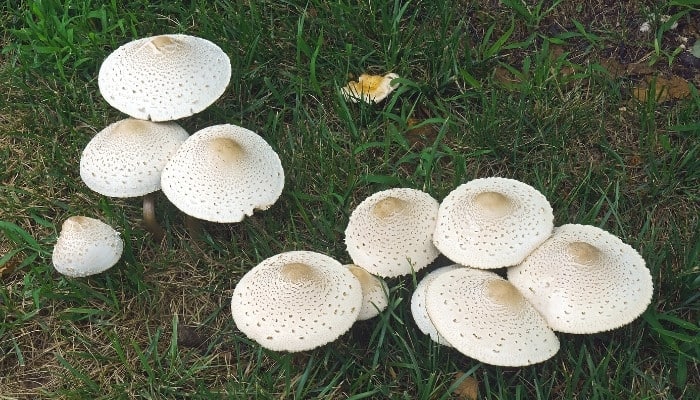If you encounter any problems while trying to rephrase the text, please let me know by responding with the error message: “Unable to process the request due to encountered difficulties.”
If you face any obstacles while paraphrasing the text, please reply with the following error message: “Unable to process the request due to difficulties encountered.”
Identify Chlorophyllum molybdites by its off-white cap with light brown scales, commonly growing in fairy rings. Its unique green spore print sets it apart from other mushrooms.
Chlorophyllum molybdites, known as Green-Spored Parasol, is a poisonous mushroom often ingested by children. Found in lawns and grassy areas it may be mistaken for harmless varieties and lookalikes.
To avoid mistakes, learn to identify the false parasol with our guide, which covers key features and common lookalikes.
Key Takeaways
- Identification: Chlorophyllum molybdites is distinguished by its off-white cap with brown scales, green spore print, and growth in fairy rings, key for distinguishing it from similar edible mushrooms.
- Toxicity: Eating this mushroom causes serious stomach problems but is not deadly. All parts of C. molybdites are poisonous, including the cap, stem, and spores.
- Lookalikes: Key differences from lookalikes include the green spore print, which sets it apart from similar-looking edible mushrooms.
Quick Guide to Chlorophyllum Molybdites Identification
About Chlorophyllum Molybdites
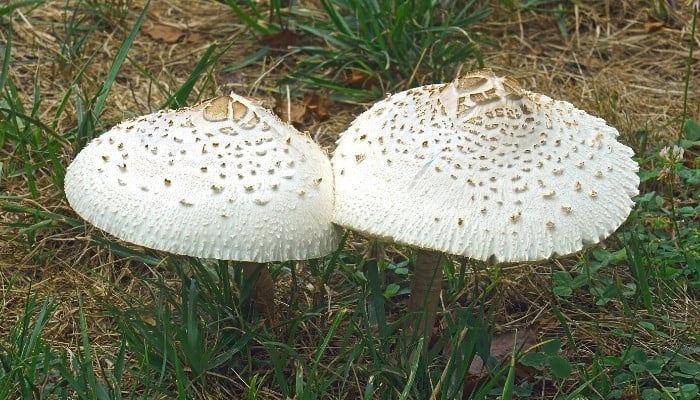
As we mentioned earlier on, Chlorophyllum molybdites, recognizable by its large-cap (3-12 inches) that starts white and becomes off-white with light brown scales, is typically found in groups or fairy rings. Its spherical cap flattens with age.
Furthermore, immature mushrooms have white gills, while mature ones display distinctive green gills and spore print. The texture of the cap, which can feel slightly slimy or sticky when wet, is another distinguishing characteristic.
The stem is thin compared to the cap, ranging from 2-12 inches in height. It closely resembles Chlorophyllum rhacodes in its immature stage, making early identification challenging.
Are Chlorophyllum Molybdites Poisonous?
Chlorophyllum molybdites mushrooms are severely poisonous for most people. Toxins in false parasols cause gastrointestinal problems including diarrhea and vomiting. The intensity of the poisoning can vary from person to person.
Poisoning symptoms usually start in 1-3 hours and last 4 hours to 7 days, depending on how much is eaten. All parts of the mushroom are toxic, with higher concentrations in the cap. Cooking reduces toxin levels but doesn’t eliminate toxicity. Some individuals can tolerate cooked false parasols, likely due to variations in stomach acid and enzymes. The poisonous part is unknown, and there is no antidote.
There is no difference in toxicity between immature and mature false parasols.
False Parasol Look-Alikes
Understanding how to identify false parasols and where they are commonly found will help you avoid accidentally consuming them.
Here are the most common false parasol lookalikes and tips to tell them apart:
Chlorophyllum Molybdites vs Parasol Mushrooms (Macrolepiota procera)
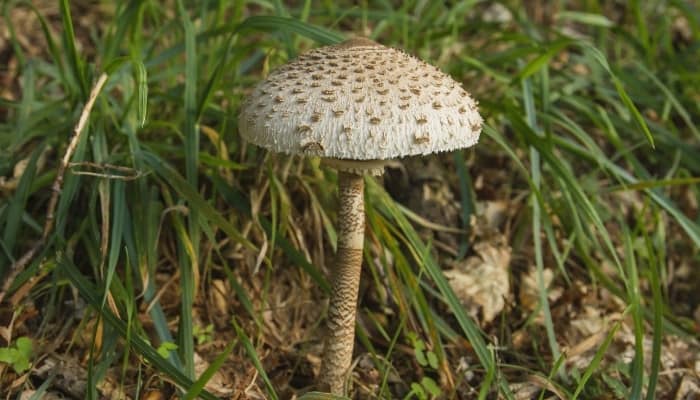
Parasol mushrooms are well-known edible mushrooms that can be found worldwide. In places like the United Kingdom, where false parasols are rare, foragers need to be less careful.
Parasol mushrooms tend to have a more pronounced snakeskin pattern of light brown scales on the cap when compared to false parasol mushrooms.
Shaggy Parasol Mushroom (Chlorophyllum rhacodes)
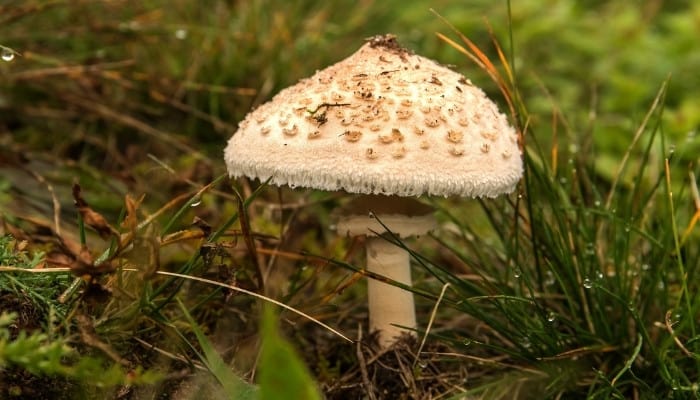
Immature C. molybdites look extremely similar to Chlorophyllum rhacodes. They both have white convex caps and can be found growing in fairy rings. To tell them apart, look at how the cap shapes change: Shaggy Parasol caps get longer and darker as they grow, unlike False Parasol caps.
Meadow Mushroom (Agaricus campestris)
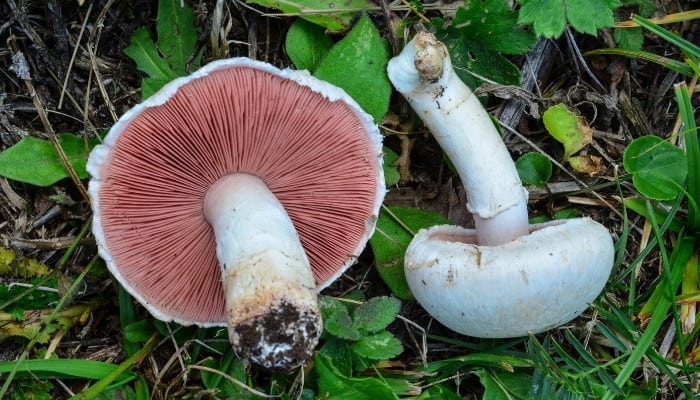
Meadow mushrooms are an edible variety that is closely related to the button mushrooms (Agaricus bisphorus) found in grocery stores.
While meadow mushrooms have similar coloration to C. molybdites, the cap and stipe are noticeably thicker. In addition, the gills and spore print of Agaricus campestris are pink to red in color.
The flesh bruises a reddish-brown color. Meadow mushrooms are another variety that forms fairy rings as they grow.
Thiers’ Lepidella (Amanita thiersii or Saproamanita thiersii)
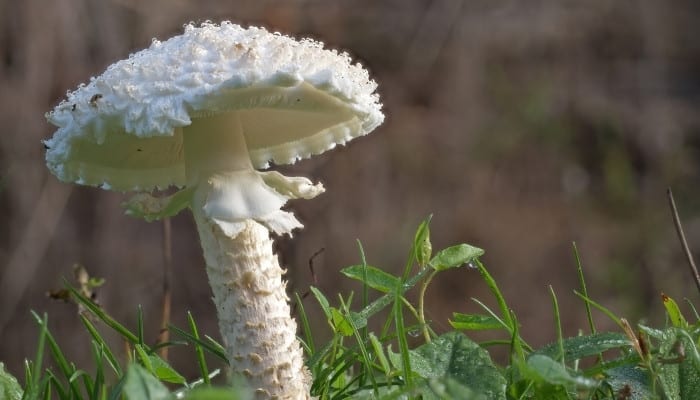
Thiers’ lepidella and false parasols have two differentiating features:
- Thiers’ lepidella mushrooms have a shaggy cap and stem and their gills remain white at maturity.
- They also grow in fairy rings in grassy locations. Thiers’ lepidella is suspected of being toxic, so it is best to avoid it.
The main difference between Thiers’ Lepidella and the False Parasol is their spore color and family. Thiers’ Lepidella belongs to the Amanita family, known for white spores, while the False Parasol, a member of the Agaricaceae family, is distinguished by its unique green spore print. This key difference in spore color is a crucial factor for identification.
Reddening Lepiota (Leucoagaricus americanus)
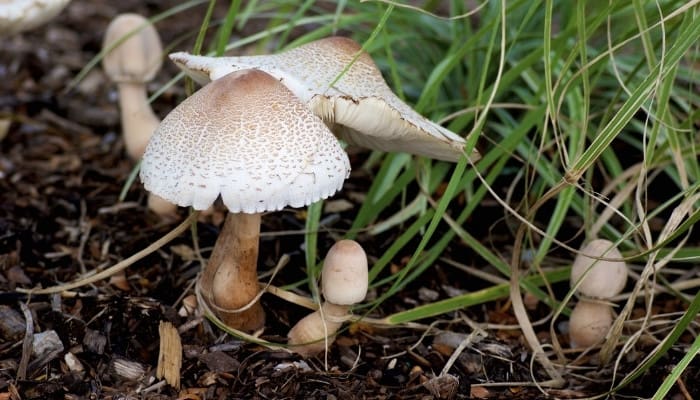
Reddening Lepiota is a toxic mushroom with a similar appearance to Chlorophyllum molybdites.
As the name suggests, reddening Lepiota turns from white to red as it ages and upon bruising.
This mushroom causes similar gastrointestinal distress to Chlorophyllum molybdites and should also be avoided.
Coprinus comatus (Shaggy mane)
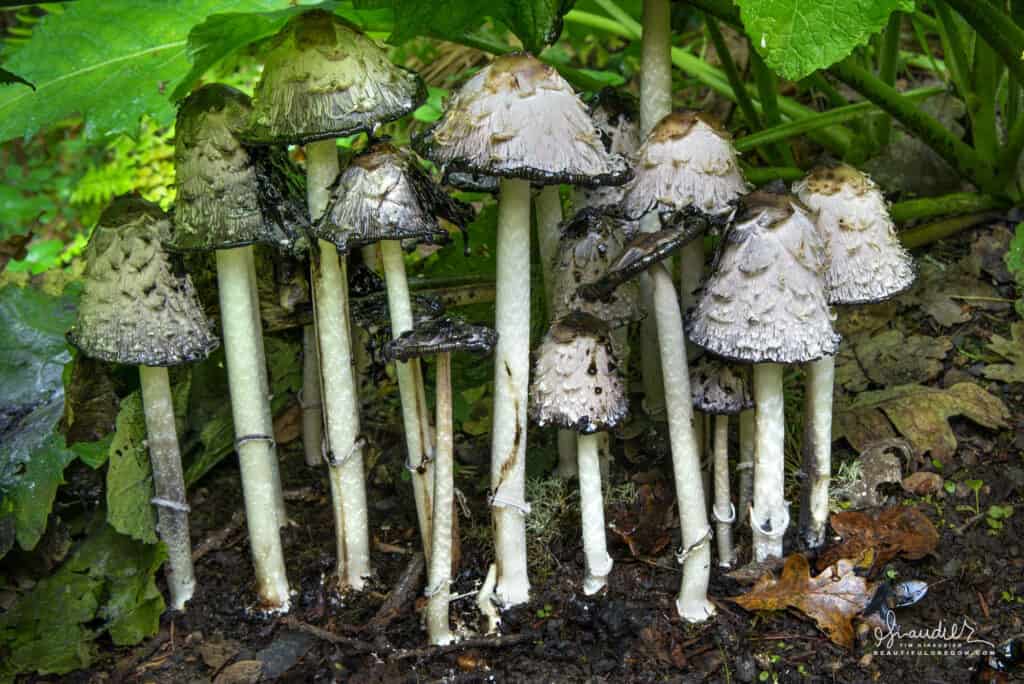
False Parasol and Shaggy mane mushrooms share similarities in their habitat and appealing appearance. Both are often found in grassy areas like lawns and parks, and their initial white caps can make them look similar to inexperienced foragers. However, their differences become more apparent with age and maturity.
Shaggy mane is unique because its cap self-digests into black ink, which False Parasol doesn’t do. Also, Coprinus comatus belongs to a different family, which is crucial in identification.
Be sure to head over to our List of 24 Toxic Mushrooms (with pics) to learn about other dangerous mushrooms to avoid.
If you want to know more about avoiding lookalikes, have a look at our article on puffball mushrooms and how to avoid puffball look-alikes too.
Frequently Asked Questions (FAQ):
What are the common names for Chlorophyllum Molybdites?
This mushroom is known by several names including False Parasol, Green-Spored Parasol, and Vomiter. “Lepiota molybdites” is another name from when it was classified in the Lepiota genus, before moving to Chlorophyllum.
Are Chlorophyllum Molybdites Deadly?
There have been no recorded deaths associated with Chlorophyllum molybdites poisonings.
Are Chlorophyllum Molybdites Poisonous to Dogs?
Chlorophyllum molybdites are poisonous to all animals, including dogs. Dogs tend to have severe reactions due to their small size compared to the size of the mushroom consumed. Their symptoms are similar to those of humans.
If your dog or pet eats C. Molybdites, call your vet or a pet poison center right away for advice.
Are Chlorophyllum Molybdites Psychedelic?
Chlorophyllum molybdites is not considered psychedelic because it does not contain psilocybin or any other hallucinogenic compounds.
Does Cooking Make False Parasols Edible?
Studies have shown that cooking false parasols does remove some of the toxins, however, it does not remove 100% of the toxins.
How To Get Rid of Chlorophyllum Molybdites
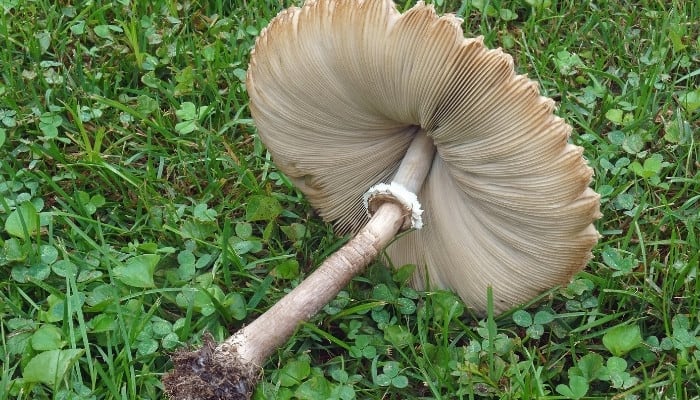
When you see a fairy ring of Chlorophyllum molybdites popping up in your yard, you can immediately remove the fruiting bodies. However, this will not kill the fungus as a majority of the fungal body is located underground.
To get rid of Chlorophyllum molybdites, you should first remove any debris from your lawn. This includes matted dead grass, plants, decaying leaves, and other organic detritus. These materials create the perfect environment for fungi, including Chlorophyllum molybdites, to thrive.
Aerating your lawn will make it a less hospitable environment for Chlorophyllum molybdites.
More details on how to improve garden soil conditions can be found in our article on Topsoil vs. Garden soil.
This can be done by wearing spikes on your shoes (find them here on Amazon) and walking through the grass or using a rolling aerator, like this towing version with 32 self-sharpening knives.
This can be repeated as needed until you see a decrease in mushroom activity.
Common Fairy Ring Mushrooms
There are estimated to be around 50 species of mushrooms that grow in fairy ring formations. (Source) Some of the common varieties are:
- Meadow mushroom (Agaricus campestris).
- Fly amanita (Amanita muscaria).
- Death cap (Amanita phalloides).
- Purple-spored puffball (Calvatia cyathiformis).
- Golden chanterelle (Cantharellus cibarius).
- Cloud funnel (Clitocybe nebularis).
- False parasol (Chlorophyllum molybdites).
- Shaggy parasol (Chlorophyllum rhacodes).
- Violet chanterelle (Gomphus clavatus).
- Common puffball (Lycoperdon perlatum).
- Parasol mushroom (Macrolepiota procera).
- Fairy ring mushroom (Marasmius oreades).
- White knight (Tricholoma album).
As we’ve learned in this article, some fairy ring mushrooms can be poisonous, while others are safe to eat. To ensure you can distinguish between them, read our article on 10 Most Poisonous Mushrooms

